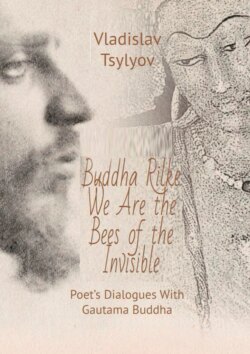Читать книгу Buddha Rilke: «We – are the bees of the Invisible». Poet’s dialogues with Gautama Buddha - - Страница 2
Mysteries Adorned with Love
A Few Words About The Buddha-Rilke Booklet Series
ОглавлениеThe proposed small book continues my series of booklets in English, under the general title Buddha-Rilke. One of my miniatures, The Gatha of the Idiot Who Plays Ball, has already been published.
Despite the much-vaunted title of the series, in which I have attempted to present some of Rilke’s views in the context of Buddha’s teachings (including in the form of speculative dialogues between the poet and the Blessed One or his successor, an unnamed Patriarch of the Chan School), these extraordinary historical figures, while expressing their judgements, in no way comment on, interpret or assert anything for the edification or ́development́ of each other. In other words, they don’t try to follow a predetermined plot, lest they find themselves
́attached to an art-thing, like an animal to a treé1.
In the words of Maeterlinck, quoted by Rilke in his famous collection ́Worpswedé,
́Progress [the development of a plot] is not at all necessary for a play to inspire us. A riddle is enough…́2
It was a fascinating riddle or mystery like this that inspired me throughout the series of booklets as I imagined these two seemingly disparate figures, Buddha and Rilke. The mystery of the spiritual connection between Buddha and Rilke, which I have tried to unravel again and again, is what I want to pass on to the reader.
R.M. Rilke
Indeed, it would be a great mistake to think that it is possible to find words for even the smallest part of that realm of the Ineffable into which the enlightened minds of these two penetrating Teachers of Life were undoubtedly initiated, or to touch with thought the sources of their insights. And certainly we should not hope that in at least one of their ́profound́ dialogues, which may even seem quite unexpected or ́advanced́ to the reader, a glimmer of Truth will suddenly appear. It’s unlikely that my modest introductions and comments on the dialogues will shed any more light on them.
Truth is everywhere, but it cannot be caught in the net of words. For its abode is beyond the boundaries of meaning, for it lurks beneath the cloak of Mystery. The only thing the reader can do is to try to peer into this mysterious ́beyond́ for himself, to lift the veil that the great artist leads him to, and finally, like a true artist, to come to the obvious conclusion: a clue does not lie in the glitter of noble names or in the sublime pathos of meanings. The best way to have an epiphany is to leave the Mystery intact.
That’s why, according to Rilke,
́…an artist seems to be even above a wise man. Where the latter strives to solve riddles, the artist has an even greater task, or, if you like, an even greater right́.3
So what ́tasḱ is Rilke talking about, and what ́right́ is he referring to? In the above-mentioned collection, the poet, speaking of art and the artist’s task, gives us a chastely clear answer:
́The work of the artist is to love the mystery. That is all art: love poured over mysteries – and that is all works of art: mysteries surrounded, adorned, showered with lové.4
As the author and compiler of The Buddha-Rilke Series, I hope that in each book of the series the reader will discover more of the exciting mysteries that Buddha and Rilke have prepared for him, mysteries surrounded and adorned with love; and that each of these books in his hands will unfold not as an insoluble challenge to reason, but as a fascinating invitation to yet another unsolved face of the Mystery.
1
́Nie ist ein Stoff bei Rodin an ein Kunst-Ding gebunden, wie ein Tier an einen Baum.́/ ́In Rodin’s work, a theme [or a subject] is never attached to an art-thing, like an animal to a tree.́
2
́Der Fortschritt ist nicht unbedingt erforderlich, damit das Schauspiel uns begeistert.́
3
́Und in diesem Sinne scheint der Künstler noch über dem Weisen zu stehen. Wo dieser bestrebt ist, Rätsel zu lösen, da hat der Künstler eine noch bei weitem größere Aufgabe oder, wenn man will, ein noch größeres Recht.́
4
́Des Künstlers ist es, das Rätsel zu – lieben. Das ist alle Kunst: Liebe, die sich über Rätsel ergossen hat, – und das sind alle Kunstwerke: Rätsel, umgeben, geschmückt, überschüttet von Liebe.́
